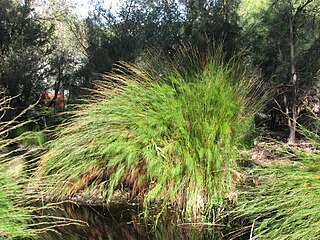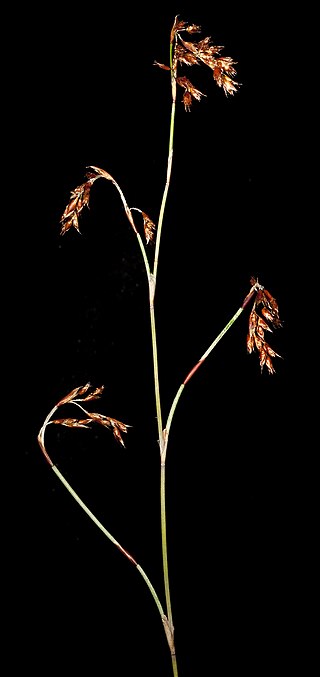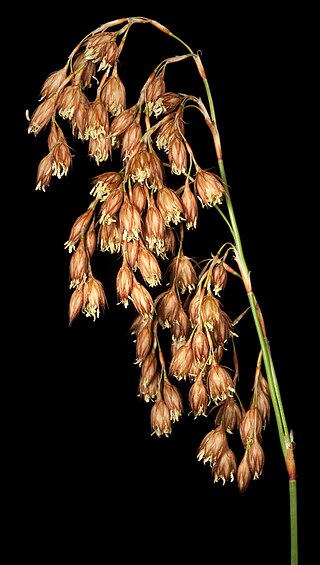
The Poales are a large order of flowering plants in the monocotyledons, and includes families of plants such as the grasses, bromeliads, rushes and sedges. Sixteen plant families are currently recognized by botanists to be part of Poales.

The Restionaceae, also called restiads and restios, are a family of flowering plants native to the Southern Hemisphere; they vary from a few centimeters to 3 meters in height. Following the APG IV (2016): the family now includes the former families Anarthriaceae, Centrolepidaceae and Lyginiaceae, and as such includes 51 genera with 572 known species. Based on evidence from fossil pollen, the Restionaceae likely originated more than 65 million years ago during the Late Cretaceous period, when the southern continents were still part of Gondwana.

Amyema quandang is a species of hemi-parasitic shrub which is widespread throughout the mainland of Australia, especially arid inland regions, sometimes referred to as the grey mistletoe.

Apodasmia is a group of plants in the Restionaceae described as a genus in 1998. It is native to Australia, New Zealand, and Chile.

Empodisma minus, commonly known as (lesser) wire rush or spreading rope-rush, is a perennial evergreen belonging to the southern-hemisphere family of monocotyledons called the Restionaceae. The Latin name Empodisma minus translates to “tangle-foot” “small”. E. minus is found from Queensland to South Australia, Tasmania and throughout New Zealand south of 38 ° latitude, or the central north island. Its current conservation status is “Least concerned”. In 2012 the new species Empodisma robustum was described in New Zealand, with what was previously described as E. minus from the lowland raised bogs of Waikato and Northland now being re-classified as E. robustum. E. minus remains an important peatformer in the south of New Zealand and in high altitude peatlands.

Alexgeorgea is a genus of three plant species found in Western Australia belonging to the family Restionaceae named in honour of the botanist Alex George in 1976. The flowers of the female and large nut-like fruit are completely underground except for the stigmas, which extend out of the ground as 3 purple or red threads.

Leptocarpus is a genus of dioeceous rush-like perennial plants described as a genus in 1810.

Baloskion tetraphyllum is a rush-like plant in the family Restionaceae. Common names include tassel rope-rush, plume rush and Australian reed.

Meeboldina is a plant genus in the family Restionaceae, described as a genus in 1943. It is named for the botanical collector Alfred Meebold.

Amyema bifurcata is an epiphytic, flowering, hemiparasitic plant of the family Loranthaceae native to Australia and found in Western Australia, the Northern Territory, Queensland and New South Wales.

Amyema nestor is a species of epiphytic hemiparasitic plant in the family Loranthaceae. It is native to Western Australia, and found growing only on acacias.

Chaetanthus aristatus is a species of rush. It is found in Western Australia.

Chordifex laxus is a rush species of the genus Chordifex in the family Restionaceae. It is endemic to the south-west of Western Australia.

Chordifex microdon is a rush species of the genus Chordifex in the family Restionaceae, native to Western Australia.
Leptocarpus laxus is a rush species of the genus Leptocarpus in the family Restionaceae. It is endemic to the south-west of Western Australia.

Sporadanthus rivularis is a sedge-like herb in the Restionaceae family, native to Western Australia. It is a spreading perennial growing from rhizomes to heights of from 1 to 1.2 m, on black sands and clay along creek edges. It is a dioecious species.

Tremulina is a genus of flowering plants belonging to the family Restionaceae. The genus was first described in 1998 by Barbara Briggs & Lawrie Johnson. The type species is Tremulina tremula.

Tremulina tremula is a plant in the Restionaceae family, found in the south-west of Western Australia.

Leptocarpus tenax is a species of plant in the family Restionaceae. It is perennial, dioecious herb found in many moist parts of eastern and southern Australia and often seen growing from 50 to 130 cm tall, with stems 1 to 2 mm in diameter. The specific epithet tenax is derived from Latin, meaning "holding fast".

Leptocarpus coangustatus is a species of plant in the Restionaceae (rush) family, endemic to Western Australia.
















